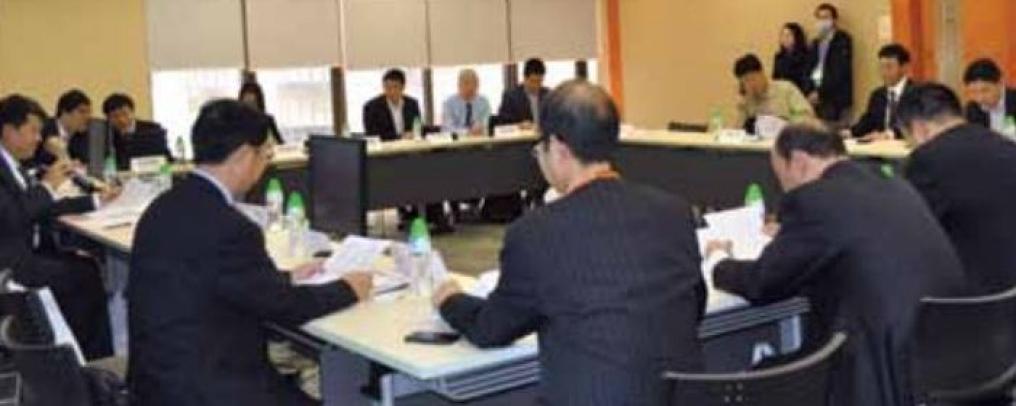Lucy Newcombe, Corporate Communications Director at Computershare, takes you through the key planning steps for AGMs to be held in Hong Kong and mainland China, and provides a look at best practice both locally and around the globe, focusing in particular on the developments that can enhance your meeting and support better shareholder engagement.
One consequence of the global financial crisis has been an increased focus on investors as stewards of companies and the constructive role they should be playing in corporate governance. Across Hong Kong and China, last year's 44% upsurge in attendance highlights the renewed interest investors have in the companies they invest in as shareholders and the potential for this to result in more searching questions being asked at your AGM. Examples in other markets in 2012 back this up – in the UK, passing resolutions at general meetings is no longer the simple box-ticking exercise it has been historically, particularly when it comes to remuneration. The global financial crisis has challenged corporate infrastructures and made shareholders more readily concerned with the business processes of the companies in which they invest, resulting in several UK CEOs vacating their posts last AGM season. In both Australia and the US, significant legislative changes to shareholder input on remuneration were enacted, making it much easier for shareholders to have an influence on this sensitive topic. Many countries have enforced, or will be moving to enforce, poll voting for all resolutions at AGMs. For some companies the AGM has historically been regarded as a matter of compliance with statutory rules and as a result planning consisted only of very basic steps. However, in the current climate where companies should be looking to strengthen engagement with shareholders, there is little room for compromise. Companies need to effectively engage with their shareholders in respect of key business decisions and assess the impact on their meeting. With changing technology (including the ever increasing role of social media), rules, market practice and legislation, it is crucial that companies are abreast of changes to ensure general meetings meet the requirements of both their own corporate strategy as well as shareholder sentiment and expectations. The message is simple – it pays to be prepared.Meeting logistics
With more than 1,000 AGMs taking place in Hong Kong and mainland China in a short space of time, it pays to book your venue well in advance if you’re not using your own office. For the larger venues, it can be a case of being prepared to adjust the dates for your AGM to ensure you get the location of your choice. Globally, a key feedback point from shareholders is that they often don’t feel an AGM location is 'central enough’ and is catered more for the convenience of the company than its shareholders. Addressing this should not be too much of a challenge in Hong Kong, but for companies located in mainland China, it's worth looking at your shareholder demographics and if you actively want investors to attend, deciding where is the optimum location to hold your meeting. In China, you also have the option of adding a virtual componentto your meeting if you cannot finda physical location that will suit the majority of shareholders. The time of the meeting should also be given careful consideration. Allowing your shareholders enough time to reach your chosen venue means you need to consider peak travelling times and public transport links when making your choice. Making sure you’ve got great signage directing shareholders to your venue is important – there's no point in them wandering around outside trying to find you when you need them to be inside voting. Finally, spare a thought for companies like Deutsche Telekom in Germany – with around 5,000 shareholders typically attending their AGM, their venue choices are limited and must be booked years in advance to ensure availability! Tip: For large meetings, to save administration time and ensure transparency in voting, consider using wireless voting technologies to allow your shareholders to cast votes. 34% of the FTSE 100 now use wireless voting technologies at their AGMs.Virtual attendance
With the April 2012 addition of new notes to Paragraph I(c) in the Corporate Governance Code (Appendix 14 of the Hong Kong Listing Rules) which requires mandatory disclosure of directors’ attendance at board and general meetings, it is now possible for directors of Hong Kong listed companies to attend by electronic means: 'I(c) attendance of each director, by name, at the board and general meetings; Notes: 1 Subject to the issuer's constitutional documents and the law and regulations of its place of incorporation, attendance by a director at a meeting by electronic means such as telephonic or videoconferencing may be counted as physical attendance.’ While board members are now expressly permitted virtual attendance at Hong Kong AGMs, which is similar to provisions in other countries including the US, UK and Australia, shareholders in Hong Kong are not yet able to take advantage of this option. This is different to mainland China where there is provision for shareholders to attend meetings virtually. Articles 20 and 21 of Chapter 4 in the Annual General Meeting Rules of The People's Republic of China states that 'Meetings should be held at a place and a time convenient to the largest possible number of shareholders to attend. Issuers should consider the use of technology (for example webcast and video conference) to maximise shareholder participation. They should clearly explain whether or not shareholders attending the general meeting by webcast at a remote site are allowed to vote and if so, how. They should not change the venue or the time of a general meeting without giving sufficient notice to shareholders.’ In the US, experiences of virtual meetings are shifting opinions and perceptions of the physical shareholder meeting, with a limited number of companies favouring the former in place of the latter. However, this approach should be carefully considered specifically with your shareholder base in mind. Some US companies have shown a strong desire to hold meetings solely online in order to reduce cost and to make the meeting more accessible to shareholders who are unable to attend in person. However, in the majority of cases this method has garnered strong objections from shareholders and companies have subsequently opted instead for a 'hybrid’ format – a physical meeting for those shareholders who wish to attend in person, supported by a 'virtual’ or online presence. A characteristic of the internationalisation of securities investment is that increasing numbers of companies have overseas investors. One of the potential consequences of this is the need to facilitate their participation at general meetings. For instance, companies in the UK with overseas investors, branch registers or dual-listings are increasingly looking to use satellite and internet technology to link video feeds of the attending board and shareholders between the sites. In Australia, virtual attendance at meetings is not expressly permitted under company law, but neither is it forbidden – so several companies have chosen to make express provision for it in their constitutional documents.A&H meetings
The meetings of A-share and H-share companies have different requirements than meetings for Hong Kong listed companies. One of the key differences is that shareholders have to be verified and registered for voting before the chairman announces the registered number of voters – which normally happens right at the start of the meeting. Therefore, those who arrive late to the meeting cannot register to vote – unlike in Hong Kong listed company meetings, where they can carry on registering to vote up until the point that the vote actually starts. This catches some shareholders by surprise – particularly if they have been used to only attending the meetings of Hong Kong listed companies. Tip: Specifically for this kind of meeting, consider arranging a small meeting room for late shareholders arriving after the participant number is announced by the host.Board preparations and legal obligations
Ensuring that your board members, and in particular the chairman, are well-prepared for the AGM is crucial. It is important to consider in advance how you will manage the order of business. Significant emphasis should be placed on the chairman's script which caters not only for the expected business, but also the possibility of requests to amend resolutions, deal with points of order or emergency situations – however unlikely. The script should also define how the chairman approaches shareholder questions. Your registrar will be able to advise you on how other companies approach this if you are newly listed or unsure as to the best practice. Tip: Increasingly, boards are adopting electronic portals viewed via tablet for all of their documentation – making it easier and quicker for revisions to take place and be distributed effectively. Across Hong Kong and mainland China this year, companies have had to address the requirement to comply with new Main Board Listing Rule 3.10A that independent non-executive directors (INEDs) are to form at least one third of the board. Companies had to comply with this requirement by December 2012 – and whilst PRC listed entities will have had to call an EGM if they needed to elect a new INED, Hong Kong, Cayman Islands and Bermuda listed companies have the ability for the board to elect a new director without an EGM. However, if a new INED was appointed in this fashion, the office is only valid until the next AGM and companies will subsequently need to ratify this appointment by requiring the new INED to stand for re-election at the 2013 AGM. Another change that companies, including those with meetings held outside Hong Kong, need to factor into this AGM season is the revision in April 2012 to the Corporate Governance Code (E.1.2) requiring Hong Kong listed companies to ensure that their external auditor attends the AGM to answer any questions that may be forthcoming about the conduct of the audit; the preparation and content of the auditors’ report; as well as the accounting policies and auditor independence. Previously, whilst auditors would be scheduled to attend Hong Kong-based AGMs, cost and time factors were often cited as a reason for them not attending meetings in the PRC or overseas.Shareholder communications
It is crucial as part of AGM planning, and in order to meet statutory requirements and best practice for corporate governance, to manage your mailing effectively and allow shareholders ample notice in order to participate. Checking the specific requirements according to your listing location, types of shareholders and articles is crucial as this varies from company to company. Tip: For A-share and H-share listings, make sure you have looked carefully at your form design in order to make it as simple as possible for shareholders to ascertain what they are being asked to do. Distinguishing the share types from each other is a good idea as it is not uncommon for shareholders to confuse the two types of shares. Communicating key shareholder information via email (in Hong Kong) or via the company's website and appointed public media (Hong Kong and PRC) means that shareholders will receive information more quickly than via traditional postal methods and even those who have perhaps forgotten to update their address details will have access to company information. In addition, it is a more environmentally friendly route of communication. Since the implementation of the 2006 Companies Act in the UK, around 70% of the FTSE 350 companies have adopted electronic communications channels as best practice, 'deeming’ shareholders to have consented to receive electronic communication unless they have specifically requested otherwise.Market and register intelligence
Ahead of your AGM it is important to be aware of both the nature of your shareholder base and how your company is perceived by key stakeholders. In mainland China, the list of registered shareholders is very transparent. In Hong Kong a bit more time is required to get to know the wider market and your register, as well as any custody nominees or large employee trust holdings, in order to anticipate any contentious issues. For a large retail organisation, keeping abreast of your customer complaints can prove beneficial in the event that these customers, who may also be shareholders, choose to voice their complaints at your AGM. The chairman can be briefed in advance in order to deal with the question effectively if posed at the meeting. If you are proposing a potentially contentious resolution, you can increase your readiness for your AGM, reduce uncertainty around the voting process and maximise your opportunity to engage with shareholders by implementing a robust shareholder identification and, if necessary, a proxy solicitation programme. Understanding who owns how many shares and their basic opinions about your business is a vital first step to understanding how they may vote on a particular resolution. Validating your resolutions against the policies of the different proxy advisors, including ISS and Glass Lewis, will also provide valuable insight into how the votes may be cast as a large proportion of institutions rely on the recommendation of proxy advisors when it comes to voting. In terms of expressing their views about your company, with the surge in popularity of social media, forums and blogs, there is no need for shareholders to wait until the AGM to air their opinions. In fact the very nature of social media means that vast online communities can be created with a common goal: to challenge your company and its business strategy. Globally, activists have been known to use social media as a tool so successfully that it has resulted in the resignation of board members and the influencing of corporate actions. Monitoring social media activity (across platforms such as Twitter, Weibo, Facebook, Renren, Youtube and YouKu) now needs to be on your AGM 'to do’ list. It is vital in order to gauge public and shareholder perception which leaves you well placed to anticipate any activist activity in the lead up to, and on the day of, your meeting. The content on these sites can help you prepare responses to questions that may be posed during the meeting, or indeed plan a proactive campaign if necessary. Social media is not only becoming a tool of choice for activist groups, it has also made journalists of members of the public, including shareholders, who are able to send updates and create 'news’ during AGMs using their smartphone. Whilst there is little companies can do to combat this, being aware of and preparing for likely contentious topics and the wider industry commentary is vital to minimise any risk of negative publicity before, during and after your AGM.Looking ahead
The high degree of focus and attention being given to the role of shareholders and the manner in which they engage with companies means that the world of the AGM is likely to be in a state of flux over the medium to long term. The Australian government is running an enquiry into the future of the AGM and shareholder engagement with the intention of planning for the future (more information is available at www.camac.gov.au, under 'Publications, Current Discussion Papers’). Various regions are considering following the example of the US and Australia and increasing legislation on remuneration votes. Russia is introducing the option for video-meetings. Locally, we think it's inevitable that virtual meetings will become a possibility for Hong Kong companies as well as those in the PRC, and that attendance will continue to rise in the next few years. The challenge for companies is to turn that attendance into meaningful contributions from shareholders that help to improve corporate governance, whilst ensuring that the AGM is the best possible experience for both the company and shareholder. Lucy Newcombe, Corporate Communications Director at Computershare Lucy Newcombe is currently based in Hong Kong. You can find her on LinkedIn or via Twitter - @lucyjayneNSIDEBAR: Rule changes 2012/ 2013
- directors may now attend AGMs by electronic means (see Notes to Paragraph I(c), Corporate Governance Code)
- independent non-executive directors (INEDs) must form at least one third of the board – where a new INED has been appointed without an EGM to comply with this requirement, he/ she will need to stand for re-election at the 2013 AGM (see new Main Board Listing Rule 3.10A)
- the external auditor must attend the AGM, including where the meeting is held outside Hong Kong (see E.1.2, Corporate Governance Code)



